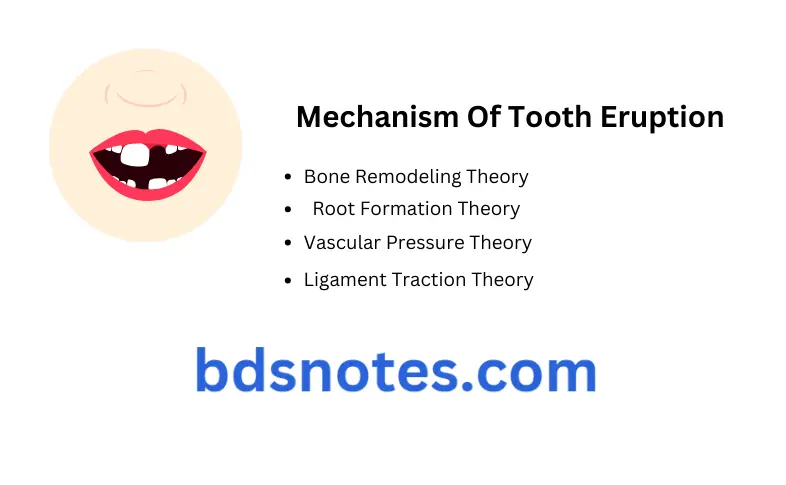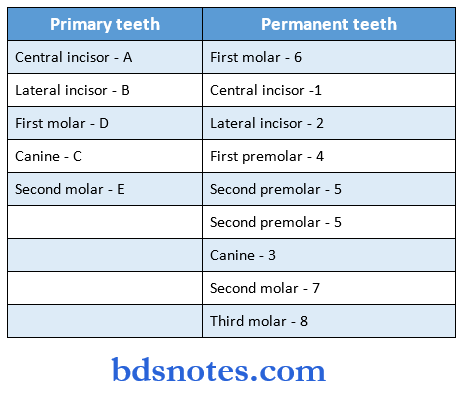Tooth Eruption
Question 1. Describe tooth eruption. (or) Describe in detail pre-eruptive, eruptive, and post-eruptive tooth movements.
Answer:
Tooth eruption:
- It means the axial or occlusal movement of the tooth from its developmental position within the jaw to its functional position in the occlusal plane.
- It consists of the following tooth movements.
Read And Learn More: BDS Previous Examination Question And Answers
1. Pre-eruptive tooth movement:
- When the deciduous tooth germs first differentiate they are extremely small and there is a good amount of space available for eruption.
- But as they grow rapidly, they become crowded.
- It is compensated by the growth of the jaws in length which permits the drifting of tooth germs The deciduous second molar tooth germs move backward and the anterior germs move forward.
- At the same time, the tooth germs are moving bodily outward and upward.
- The re-eruptive tooth movement is made by the deciduous and permanent tooth germs within the tissues of the jaw before they begin to erupt.
- The permanent tooth buds which arise lingual to the deciduous predecessors migrate in a buccal direction.
- The pre-eruptive movements occur in an intraosseous location and are reflected in the patterns of bony remodeling within the crypt wall.
2. Eruptive tooth movement:
- It is made by a tooth to move from its position within the bone of the jaw to its functional position in occlusion.
- It includes the formation of the roots, the periodontal ligament, and the dentogingival junction.
- Root formation is initiated by the growth of Hertwig’s epithelial root sheath.
- It overall increases the length of the tooth.
- Depending on the rate at which the root elongates the basal bone will resorb or form to maintain a proper relationship between the root and bone.
- Shortly after the onset of root formation, the cementum, periodontal ligament, and the bone lining the crypt wall are formed.
- A number of structural changes occur in the periodontal ligament that is responsible for tooth movement.
3. Post-eruptive tooth movement:
- Maintaining the position of the erupted tooth in occlusion while the jaws continue to grow and compensate for occlusal and proximal tooth wear.
- It is made by the tooth after it has reached its functional position in the occlusal plane.
- They are divided into three categories.
- The movement to accommodate the growing jaws.
- They are completed towards the end of the second decade.
- The tooth is readjusted to the growing jaws by the formation of new bone at the alveolar crest and on the socket floor.
- Readjustment occurs between the ages of 14 – 18 years.
- During this active movement of the tooth takes place.
- Movements to compensate for occlusal wear.
- Compensation for occlusal wear is achieved by continued deposition of cementum around the apex of the tooth.
- Movements to accommodate interproximal wear.
- The interproximal wear is compensated by a process mesial drift.
- The forces causing mesial drift may include occlusal force, contraction of the transseptal ligament between teeth, and soft tissue pressure.
Question 2. Describe briefly the theories of the eruption of teeth. Add a note on clinical considerations related to tooth eruption.
Answer:
Theories of the eruption of tooth:
1. Bone remodeling theory:
- It proposes that selective deposition and resorption of bone bring about eruption.
- It has been established that the dental follicle is absolutely required for it.
- This follicle provides the source for new bone-forming cells and a channel for osteoclasts that are derived from monocytes.
- This theory was rejected as the tooth continues to erupt even after the selective removal of the dental follicle.
2. Root formation theory:
- It proposes that the proliferating root impinges on a fixed base thus converting an apically directed force into occlusal movement.
- According to this theory, the root requires a fixed base to translate the apical force into occlusal movement.
- Thus, it postulated the existence of a cushion hammock ligament to provide a fixed base for the growing root to react against.
- This theory was rejected because.
- It is the crown that moves away from the root.
- Root elongation may exert pressure and cause resorption of bone at the base of its socket.
- The Hammock ligament has no bony insertion thus it cannot act as the fixed base.
- some teeth move greater than their root length.
- Even rootless teeth erupt.
3. Vascular pressure theory:
- It proposes that a local increase in tissue fluid pressure in the periapical region is sufficient to move the tooth.
- Teeth move in synchrony with the arterial pulse, so local volume changes can produce limited tooth movement.
- Ground substance can swell by 50% with the addition of water and a differential pressure sufficient to cause tooth movement between the tissues below and above an erupting tooth has been reported.
- Through vascular pressure can play an important role by generating an eruptive force, different opinions have been put forward as to whether these pressures are primarily responsible for eruption.
4. Ligament traction theory:
- It proposes that the cells and fibers of the ligament pull the tooth into occlusion.
- According to this theory, force is initiated by the fibroblast causing an eruption of teeth.
- This force is transmitted to collagen fiber bundles.
- Once the tooth has appeared in the oral cavity and before it attains its final position, the periodontal ligament fibers exert the tractional force due to its attachment to the alveolar bone and to its orientation.
- When the formation of collagen is inhibited with drugs and when fibroblastic activity is stopped in the periodontal ligament area, eruption stops.
- Thus, this theory is the most accepted theory.
Ligament traction theory Clinical considerations:
- The periodontal ligament and the bone of the jaw possess elasticity which is used for orthodontic movement.
- The eruption schedule of teeth helps in the assessment of dental age.
- Sometimes natal and neonatal teeth appear.
- Premature loss of deciduous may lead to delayed eruption of permanent and drifting of opposite teeth which block the eruptive pathway.
- Severe trauma may eliminate dental follicles which prevents periodontal ligament formation.
- When the tooth breaks through the oral epithelium, an acute inflammatory response occurs in the connective tissue adjacent to the tooth.
- Teeth that erupted beyond an occlusal plane are known as supra-erupted teeth.
- Teeth lying below the occlusal level are submerged teeth.
- Ankylosed teeth do not undergo posteruptive movement.
Question 3. Mechanism of Tooth Eruption.
Answer:
- To explain the mechanism of tooth eruption various theories have been proposed.
- Some of them are
- Bone remodeling theory.
- Root formation theory.
- Vascular pressure theory.
- Ligament traction theory.

Question 4. Root growth theory of eruption
Answer:
- It proposes that the proliferating root impinges on a fixed base thus converting an apically directed force into occlusal movement.
- According to this theory, the root requires a fixed base to translate the apical force into occlusal movement.
- Thus it is postulated the existence of a cushion hammock ligament to provide a fixed base for the growing root to react against
- This theory was rejected because
- It is the crown that moves away from the root
- Root elongation may exert pressure and cause resorption of bone at the base of its socket
- The Hammock ligament has no bony insertion thus it cannot act as a fixed base
- Some teeth move greater than their root length
- Even rootless teeth erupt
Question 5. Theories of eruption.
Answer:
1. Bone remodeling theory.
- It proposes that selective deposition and resorption of bone bring about eruption.
2. Root formation theory.
- It supposes that the proliferating root impinges on a fixed base, thus converting an apically directed force into occlusal movement.
3. Vascular pressure theory:
- It supposes that a local increase in tissue fluid pressure in the periapical region is sufficient to move the tooth.
4. Ligament traction theory.
- It proposes that the cells and fibers of the ligament pull the tooth into occlusion.
Question 6. Hydrodynamic theory.
Answer:
- It is also called vascular pressure theory.
- It supposes that a local increase in tissue fluid pressure in the periapical region is sufficient to move the tooth.
- Experiments have shown that an increase in hydrostatic pressure increases the rate of eruption while a decrease in hydrostatic pressure decreases the rate of eruption.
- But it has not been proved whether this pressure is primarily responsible for eruption.
Question 7. PDL traction theory.
Answer:
- It proposes that the cells and fibers of the ligament pull the tooth into occlusion.
- It is the most accepted theory.
- According to this theory, forces initiated by fibroblast present in PDL could be responsible for tooth eruption.
- During the conversion of procollagen to collagen in the PDL, a contraction of fibroblasts causes tractional force.
- This force is transmitted to the collagen to cause tooth eruption.
- When collagen formation is inhibited and fibroblastic activity is stopped, eruption stops.
- Thus, this theory is accepted.
Question 8. Eruption dates of deciduous and permanent teeth.
Answer:

Question 9. Sequences of the eruption of deciduous teeth.
Answer:
- The sequence of eruption of deciduous teeth is
- A B C D ELower central incisor
- Upper central incisor
- Lower lateral incisor
- Upper lateral incisor
- First molars
- Canines
- Second molars.
Question 10. Sequences of maxillary teeth eruption.
Answer:

Question 11. Active and passive eruption of teeth.
Answer:
1. Active eruption:
- The eruption is the process of an axial or occlusal movement of the tooth from its developmental position within the jaw to its functional position in the occlusal plane.
- This active movement of the tooth is an active eruption.
2. Passive eruption:
- The exposure of more and more clinical crowns due to apical migration of junctional epithelium is called passive tooth eruption.

Leave a Reply